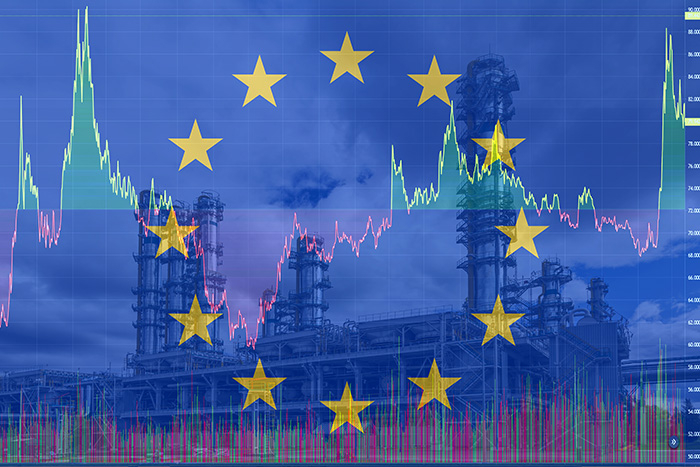Interviews / Energy and Raw Materials
3 August 2023
“The Eu’s Gas Policy Has Yielded Positive Results with New Supplies.”

Europeans have turned to new gas exporters after the shutdown of the Nord Stream 1 and 2 pipelines, which connect Russia to Germany via the Baltic Sea. Have they succeeded in diversifying their supply sources?
This trend began before the sabotage of Nord Stream 1 and 2 at the end of September 2022. It is a reaction to the war in Ukraine. Since the spring of 2022, the European Union (EU) has made significant efforts to reduce its reliance on Russian gas. In March 2022, the EU made the historic decision to completely phase out Russian gas in the medium term. This is a major challenge, as Russia was its main supplier. The EU’s gas policy has led to concrete results. The first agreement to seek gas supplies elsewhere than Russia, and the most significant, was concluded in 2022 with the United States, which plans to increase exports of liquefied natural gas (LNG) to the EU. Subsequently, the EU signed two more gas agreements. One is a tripartite agreement between Europe, Egypt, and Israel, which aims to increase exports from these two gas-producing countries in the coming years, specifically through LNG. There are also pipeline projects, such as the EastMed project, which would link Israel to the EU via Cyprus, Greece, and Italy. Another project considers establishing a pipeline between Israel and Turkey to connect Israel with European countries. However, these are only projects, and nothing is concrete yet, with their prospects limited by geopolitical reasons. A third agreement in 2022 was concluded between the EU and Azerbaijan, with Azerbaijan committing to increase gas deliveries through pipelines by 2027. The Southern Gas Corridor, which links Azerbaijan with the EU, currently consists of three pipelines. Given the context of the war in Ukraine, Europeans are seeking quick solutions, but constructing a new pipeline in this emergency situation is not an option. Therefore, Azerbaijan has a significant advantage here. There are two ways to export gas: via pipeline or as LNG, which can be transported by LNG carriers. LNG is more expensive but offers the advantage of securing gas supplies. European countries have LNG terminals, allowing them to import from multiple exporters and diversify their supply sources. LNG thus provides greater energy security and is becoming an increasingly attractive option. The geopolitical risks associated with pipelines, such as sabotage, are real, as seen during the Ukraine war. While pipeline delivery is cheaper, it is more rigid because gas can only be transported through fixed pipelines connecting the involved countries.
At the same time, several European countries have signed gas agreements. First, between Algeria and Italy to increase Algerian gas deliveries via pipeline across the Mediterranean. Berlin signed three more agreements: 1) between Germany and Qatar, 2) between Germany and the United Arab Emirates, and 3) between Germany and Australia. In all three cases, the imported gas is LNG. Before the invasion of Ukraine, Italy and Germany were particularly dependent on Russian gas. Furthermore, a new pipeline, the “Baltic Pipe,” came into operation at the end of 2022, linking Norway, Denmark, and Poland. In total, eight gas agreements have been signed by Europeans in less than a year to diversify their supply sources, which is unprecedented. In response to an exceptional situation, the EU has offered an exceptional response. Additionally, other agreements are under discussion. France has been negotiating with Algeria since 2022, while Germany is negotiating with Oman, but no agreement has been reached yet between these countries. Other potential sources are also being considered, such as Canada and sub-Saharan African countries. Regarding Lebanon, it is currently only exploration, with no discoveries made. The horizon for this option is further off. The consortium including TotalEnergies, the Italian group Eni, and QatarEnergy is currently exploring resources in Lebanese waters. If a discovery were made and qualified as commercially viable, it would take years before production could begin, as a gas field would need to be developed. Lebanon is a possible solution in the long term, but it is out of the running in the context of the Ukraine war, as Europeans are looking for short- and medium-term solutions.
In the Eastern Mediterranean, Turkey is seeking to establish itself as a gas hub for both the international and Turkish markets. It remains a key transit route for Russian gas, with the TurkStream and BlueStream pipelines passing through the Black Sea. Turkey itself is still dependent on Russian gas. In 2021, it consumed 60 billion cubic meters of Russian gas, and the country relies on Russia for 45% of its supply.
Turkey is an important player for Russia, the EU, and the Caspian Sea region. The BlueStream pipeline (Russia – Black Sea – Turkey) supplies the Turkish market, while gas transported through the TurkStream pipeline (Russia – Black Sea – Turkey – EU) is intended for both Turkey and the European market. Currently, Russian gas is still arriving in EU states, but the volumes have significantly decreased since early 2022, and this trend is ongoing. Additionally, Turkey facilitates the transit of Azerbaijani gas through the Southern Gas Corridor (SGC), which connects Azerbaijan (a gas producer in the Caspian Sea, offshore Baku), Georgia, Turkey, and the EU (up to Italy). This 3,500-kilometer pipeline network has been fully operational since December 2020. The first pipeline, the Southern Caspian Pipeline (SCP), connects Azerbaijan and Georgia to the Turkish border. The TANAP pipeline then continues across Turkey from the Georgian-Turkish border to the Turkish-Greek border, and it connects to the TAP (Trans Adriatic Pipeline), which serves Greece and Italy and is linked to other European pipelines. Additionally, Turkey imports LNG and produces its own gas for the Turkish market. In April 2023, Turkey brought an important gas field into production in the Black Sea, Sakarya. However, it is not sufficient to meet national consumption. Turkey is striving to become a hub for the transit of gas from producing countries to the EU. Its geographical positioning allows it to act as a crucial transit point. This is already the case for Azerbaijani gas via the Southern Corridor. To capitalize on its geographical advantages, Turkey proposed building a pipeline with Israel to allow the country to export gas to Europe through Turkey. However, given the past relations between Israel and Turkey, it seems unlikely that Israeli leaders would trust Erdogan enough for such a project, which requires long-term commitment. There is also talk of a Trans-Caspian pipeline that could allow Turkmenistan to transport its gas through the Caspian Sea via Azerbaijan. It would then use the network passing through Turkey to deliver gas to the EU. Turkey also aims to serve as a transit route for Iraqi gas. Iranian gas exports to Europe could also, in the future, pass through Turkish territory. However, US sanctions currently make this option unfeasible.
As for Azerbaijan, are its gas reserves sufficient for the European market in the coming years?
Azerbaijan’s gas reserves are expected to meet EU gas consumption for many years. The total investments required to complete the Southern Corridor, which exports Azerbaijani gas to Georgia, Turkey, and the EU, are estimated at around 40 billion dollars. This is a considerable amount. In 2022, Azerbaijan committed to increasing its gas exports to EU countries in the coming years.
From Les clés du Moyen-Orient.

